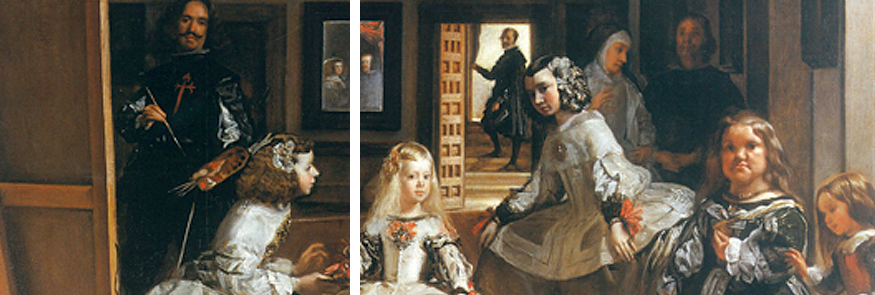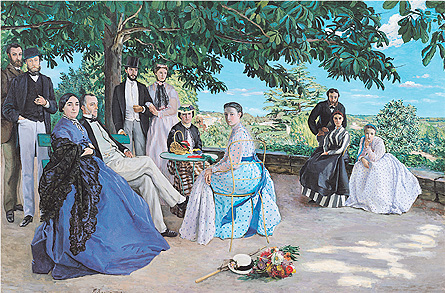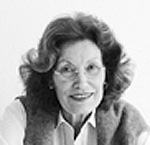Family portraits
A journey through art history

In the bourgeois era the family, as society’s primary unit, became socially acceptable as the subject of a picture; until then it had been the nobility who left their mark on this art form. The family’s changing political and social status is therefore reflected in the images passed down to us in painted form – images which at the same time bear the distinctive hallmark of the creative minds that shaped them. At times when status-boosting hyperbole was the order of the day, artists sought out and explored the cracks in the image; elsewhere, domestic intimacy is appropriated to serve patriotic ends. These are just some of the conclusions to be drawn from the six family portraits – all major works in terms of art history – selected and presented here by Wibke von Bonin. by Wibke von Bonin
1.
They kept hunting dogs and court dwarfs; the ladies curtseyed in their big hooped skirts, the men wore ruffs. They ruled over countries far and near and enjoyed the fruits of their conquests. Wealth and splendor combined with stringent etiquette: Life at the court of Philip IV, depicted in fabulous detail in the painting “Las Meninas” (1656, The Maids of Honor) by court painter Diego Velázquez (1465–1524), offers no hint of the fact that elsewhere in Europe the consequences of the Thirty Years’ War were still unraveling and that the power of the Spanish royal family was steadily dwindling, hanging like a sword of Damocles over Madrid. The succession was at risk. Of the king’s eight children born in wedlock only one daughter was still alive in 1649 when he married his second wife: Maria Anna of Austria, previously the fiancée of his own son and heir, who had died not long before. He was 42, she was just 15 – and his own niece, into the bargain.
The first child born of this marriage was Margarita, shown as a five-year-old at the center of this painting – known as “La Familia” from the 18th to the mid-19th century and one of the most admired and debated paintings in the history of art. We know the names of the young noblewomen who lean towards the princess, and of the dwarfs to the right of the picture and the people behind them. Yet the viewer’s interest is focused on the two bright rectangles at the far end of the room. Here we can make out – the identification is almost undisputed – a reflection in a mirror of the king and queen, while the backlit figure of court chamberlain José Nieto appears on a staircase to the right. Nieto’s job as the king’s attendant was to open doors for his royal master; his presence in the family picture is regarded as evidence that the two reflected figures – shown as half-length portraits – are indeed Philip IV and his wife, even though it was not really the proper thing to show their majesties in anything other than their full-size glory.
Diego Velázquez could clearly afford a breach of etiquette – which he compounds by including himself as painter in the picture, and larger than all the other figures. The king had granted him a residence and studio in his palace of Alcázar – where a chair was specially reserved for the king’s own frequent visits. The most probable theory, therefore, is that the royal couple is located – along with the viewer – in front of the picture, being immortalized by Velázquez on the enormous canvas while the figures depicted in the painting observe him at work. The princess was married to Leopold I, Holy Roman Emperor, at the age of 15 and died at 22. An heir, Carlos II, had at last been born ten years after Margarita Teresa; when he died in 1700 the Spanish Habsburg line – weakened by intra-familial marriages – came to an end.
2 .
Exactly one hundred years later Francisco de Goya (1746–1828) painted his king and the royal family in a work entitled “La familia de Carlos IV” (Carlos IV of Spain and His Family). The king was considered mentally retarded; he left the business of government to his wife María Luisa de Parma – also his first cousin – and a senior officer in the Spanish army, Manuel de Godoy, who was also her lover and fathered the youngest of her 14 children. Goya was the king’s First Court Painter from 1799 onwards and was commissioned by him to produce this large-format family portrait at Aranjuez palace – a painting whose unsparing realism makes it one of the iconic works of portrait art. Like Velázquez, Goya also included himself in the picture, although in much more restrained fashion – he stands in half-shadow to the left, behind the future King Fernando VII. The latter looks confidently out of the picture, the only figure whose face is picked out by the light which falls from the left. This light also illuminates the full bosom of the lady next to him, whose face was deliberately left anonymous, leaving space to add the features of the prince’s spouse – who had not yet been selected. The queen dominates the center of the picture with her shimmering gold robe and a positively impertinent expression. Her arms reach down to the children fathered by Godoy; little Francisco de Paula peeks out of the picture with a terrified, beseeching air, while the huge, insignia-bedecked king gazes listlessly into the distance. Also portrayed are his siblings and their children, the future rulers of Portugal and Parma. The course of European history was determined, or impeded, by these people – and Goya’s merciless candor provides art history with evidential proof that the concept of a dominant elite ruling over its people would have to come to an end. As an alert, critical citizen of the revolutionary era he could take the liberty of unmasking the nobility in their portraits.
3 .
In the 17th century, while other nations were engaged in wars with each other, the Dutch – freed now from Spanish rule – were able to concentrate on business, trade, knowledge, and culture. The Dutch had no king ruling over them; an urbane upper class of bankers, merchants, ship owners and senior officers held sway. In the cities art flourished, an educated bourgeoisie enjoyed their economic success and savored the luxuries captured by painters in the popular still-lifes and portraits. Jan Steen (c. 1626 –1679) – son of a brewer from Leiden and a bohemian character whose fortunes fluctuated during his career – was not the most important of these painters but he was one of the most industrious and amusing. In his genre scenes he liked to depict ordinary citizens enjoying festive occasions.
His “Merry Family” displays the entire dramatis personae of a typical, much-varied scene: men and women of all ages enjoying themselves, eating, drinking and playing music; a happy throng of juxtaposed family members, right down to the baby on the mother’s lap – cared for, marveled at, petted – and a little dog in the foreground.
4 .
By contrast there is nothing turbulent about “Réunion de famille”, an upper-class family gathering in the French provinces, as painted by Frédéric Bazille (1841–1870) around 1850 – two hundred years later. More significant in art historical terms is that the scene takes place out of doors. The artist from Montpellier has arranged his close relatives in groups on a countryside terrace, in the shadow of a large tree. His parents sit in the left foreground, behind them stand his brother Marc and – at the far edge of the picture – Bazille himself. We know the names of the individual figures and their relationship to the artist – the sister-in-law, the cousins, the Doctor and his wife. Yet they are of interest chiefly to this genteel family’s descendants. Contemporary viewers of this large painting enjoy the young ladies’ gossamer-light summer dresses, the patches of sunlight on the ground and the magical little still life of hat, stick and bouquet in the foreground. And marvel at the solemn seriousness of the faces – almost all looking towards a point outside the picture, beyond the foreground. Had the picture been painted a few decades later we might see a reference to a quasi-photographic perspective here.
The painter was a friend of the Impressionists, especially Claude Monet. Three years after depicting this peaceful summer idyll, in November 1870, Frédéric Bazille was killed in the Franco-Prussian war, never to turn 30 years old.

5 .
It was not possible to survive as a portrait painter in early 18th-century America. Talented artists also worked in a craft profession – as house painters or gilders, for example. As trade prospered, great fortunes were made in cities like Boston and Philadelphia, yet it did not occur to the newly affluent middle class to patronize the arts. Only later generations, and generally the descendants of English colonists, managed to overcome the limitations of colonial painting through their contacts with master painters in the homeland of their forebears.
Charles Willson Peale (1741–1827), a self-taught artist who studied for several years in London, was the first painter confident enough to return home and seek his fortune there. At that time Philadelphia was the biggest city in the United States, with 70,000 residents, and the wealthiest, too. And by this stage a prosperous citizen like John Cadwalader was more than happy to put this wealth on display. He commissioned no less than five works for his family residence from Peale, including the “Portrait of John and Elizabeth Lloyd Cadwalader and Their Daughter Anne”. This family portrait with his wife and daughter was painted in 1772. The head of the household adopts a forthright, assured pose, while his wife – wearing a sumptuous silk dress, her hair arranged in the rococo style – looks up to him confidently. He is handing a ripe peach to his little daughter and gazes thoughtfully down at both of them. The painting radiates a calm satisfaction. The couple do not look beyond the picture but are occupied with their child – who will profit from their wealth and will probably be raised in accordance with the moral principles of the age.
The rigorous realism of Peale’s style reflected his self-appointed mission as an artist. The country needed pictures of its eminent citizens and heroes. The artist was a fervent patriot: He joined the civil militia in the War of Independence, fighting with them from 1776 onwards and quickly forging a military career. He became the fledgling republic’s first painter of historic scenes, producing pictures of battlefields and victors, and numerous portraits of George Washington – the first of which dates from 1772.
6 .
Norman Rockwell (1894–1978) was also a presidential portraitist. Yet long before his portraits of Dwight D. Eisenhower, Richard Nixon and John F. Kennedy were published for a mass audience on the title pages of the Saturday Evening Post, the artist was already a household name in America, his characters as popular as those of Walt Disney. Rockwell was 22 years old when his first illustration appeared in a popular magazine in 1916; there would be nearly 300 of them in all over a span of nearly 50 years. People love his pictures because they idealize the average American family – with a touch of gentle humor.
One of his most famous pictures is “Freedom from Want”, painted in 1942. An extended family gathers around the table on Thanksgiving Day, chatting and in high spirits, while the housewife serves up the traditional turkey, which will imminently be carved by the head of the family. There is no want here – but no high-living, either: the glasses are filled with water. This is a puritanical, healthy world, viewed from a standpoint at the end of the table which also includes the viewer. The viewer might be a guest at the table, might feel included, invited by the man in the right foreground. At any rate there seems to be enough space and food for everyone. The idyll of sufficiency is depicted with such precision that this might be a photograph.
This is one of the “Four Freedoms” illustrations inspired by President Franklin D. Roosevelt’s eponymous State of the Union address to Congress in 1941. The artist came up with memorable images to express freedom from want and from fear, freedom of speech and freedom of worship. These freedoms – it is implied – were worth fighting for; the American public, the majority of whom were at this stage opposed to the USA’s intervention in World War II, should stand up for them. The Saturday Evening Post printed the Four Freedoms in February/March 1943. Norman Rockwell, who was unable to take part in the battle for the American dream of freedom and prosperity for everyone, saw his freedom illustrations as persuasive endorsements of President Roosevelt, whose economic program called for significant sacrifices on the part of the American people.
Powerful images of the family have come down to us, spanning long periods of history, and mediated in particular by works of art. Whether they were produced against a backdrop of dynastic or bourgeois aspirations, these works stand out, above all, when they also reveal the artist’s personal viewpoint. Today photographers have joined, but not replaced, these artists. Because, contrary to the early adage which equated photography with objective reproduction, this medium too is used in a highly artistic way. Thomas Struth’s family portraits are just one example – albeit an extraordinarily original one.

Wibke von Bonin
Wibke von Bonin has a PhD in art history. As arts editor for German broadcaster WDR she documented the international art scene with films and series on art historical subjects spanning all ages and cultures. Her TV series on “100 masterpieces from the world’s major museums” – for which she also edited an accompanying series of books – was especially popular. Her articles on art are published in books, magazines, and exhibition catalogues.
PHOTOS: PICTURE ALLIANCE/UNITED ARCHIVES (VELAZQUEZ); PICTURE ALLIANCE/ARTCOLOR/A. KOCH (GOYA); PICTUREALLIANCE/AKG-IMAGES/ERICH LESSING (STEEN); PICTURE ALLIANCE/AKG-IMAGES (BAZILLE); PHILADELPHIA MUSEUM OFART/CORBIS (PEALE); CORBIS (ROCKWELL)





